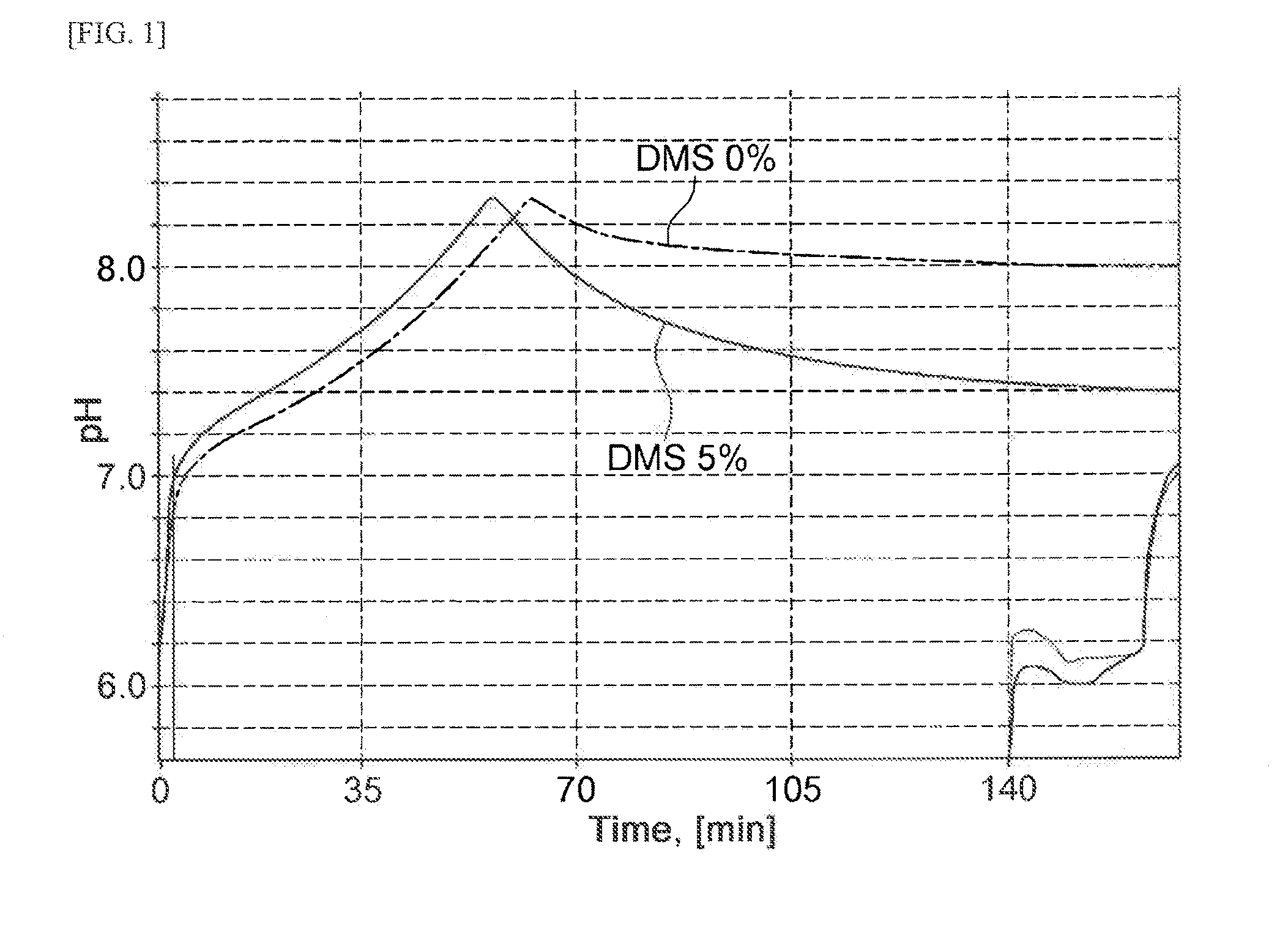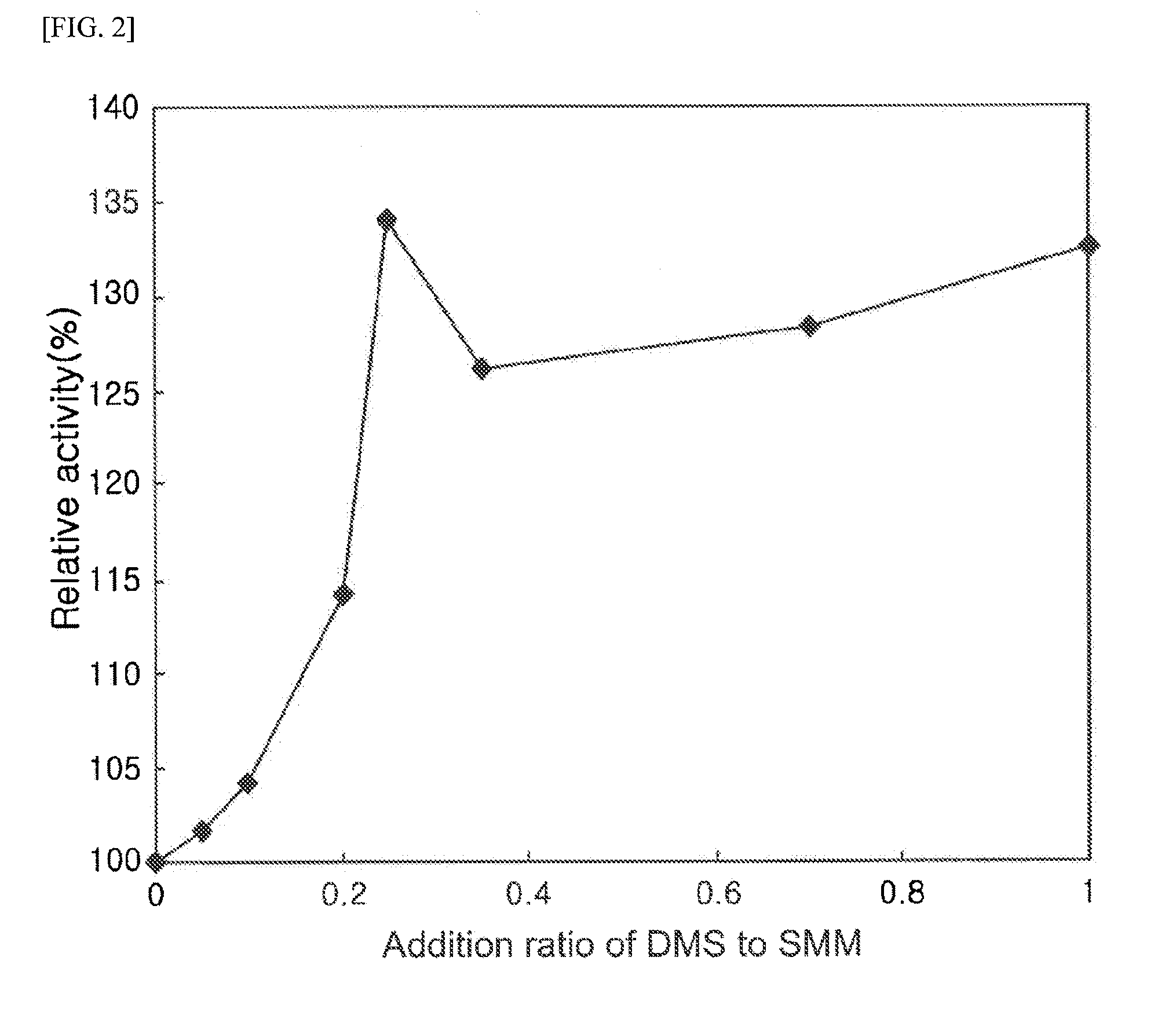Method for Increasing Methionine Productivity Using a Mixture of Methyl Mercaptan and Dimethyl Sulfide
a technology of dimethyl sulfide and methyl mercaptan, which is applied in the field can solve the disadvantages of chemically synthesized methionine in the mixture of l- and d-forms, and achieve the effects of improving the productivity of l improving the production rate and purity of l-methionine and organic acid, and saving the cost of reaction
- Summary
- Abstract
- Description
- Claims
- Application Information
AI Technical Summary
Benefits of technology
Problems solved by technology
Method used
Image
Examples
example 1
Comparison of Conversion Rate of Methionine from O-Acetyl Homoserine According to Mixing Ratio of Methyl Mercaptan and Dimethyl Sulfide
[0045]Upon conversion reaction, dimethyl sulfide was mixed with a methyl mercaptan solution at a appropriate ratio, and the mixture was added to a conversion reaction solution so as to examine the conversion rate of methionine from O-acetyl homoserine.
[0046]Methyl mercaptan exists as a gas at room temperature, and may exist in a form of sodium methyl mercaptan solution (sodium methyl mercaptan, CH3S—Na, 2.14 M, 15%, Tokyo chemical industry, Japan) by adding it to a sodium hydroxide solution. In the present Example, a 2.14 M sodium methyl mercaptan solution was used to perform the experiment. Hereinbelow, the 2.14 M sodium methyl mercaptan solution will be designated as a methyl mercaptan solution. The methyl mercaptan solution and dimethyl sulfide solution (13.38 M, 99%, arkema, France) were mixed at a appropriate molar ratio (mol:mol), and stirred t...
example 2
Conversion Reaction of Methionine Using Mixture of Methyl Mercaptan and Dimethyl Sulfide
[0052]To examine whether the improved production of methionine continuously occurs under the same conditions as in Example 1, the production of methionine was examined while the mixture of methyl mercaptan and dimethyl sulfide was continuously added according to time. The reaction was maintained using the same conversion reaction solution for 30 min while the methyl mercaptan solution and the mixture with dimethyl sulfide were added every 10 min. After 30 min, the reaction was terminated, and the amount of produced methionine was measured by HPLC. The reaction was performed under the condition of the mixing ratio of methyl mercaptan solution and dimethyl sulfide of 1:0.25 (mol:mol), at which the highest production of methionine was observed in Example 1. The results are shown in the following Table 2.
TABLE 2Comparison of conversion rates according to continuous supply of methylmercaptan solution ...
example 3
Enzymatic Conversion Reaction of O-Acetyl Homoserine in 1 L Batch Reactor
[0054]To examine the efficiency of conversion reaction in a large-scale reactor, the reaction was performed using 500 mL of 700 mM O-acetyl homoserine in a 1 L batch reactor. The enzymatic conversion reaction was performed while continuously supplying the methyl mercaptan solution or the mixture of methyl mercaptan and dimethyl sulfide of 1:0.25 (mol:mol) at a flow rate of 3.0 mL / min for 60 mM. The amount of methyl mercaptan contained in each solution was adjusted to be identical. The reaction temperature was 33° C. and the agitation was performed at 700 rpm. The converting enzyme liquid was prepared in the same manner as in the above Example, and 10 mL thereof was added. 0.1 mM pyridoxal 5′-phosphate (Sigma, USA) as a cofactor was added. After about 3 hrs, the amount of produced methionine was measured by HPLC. The results are shown in the following Table 3.
TABLE 3Comparison of conversion rates according to su...
PUM
| Property | Measurement | Unit |
|---|---|---|
| temperature | aaaaa | aaaaa |
| solubility | aaaaa | aaaaa |
| purity | aaaaa | aaaaa |
Abstract
Description
Claims
Application Information
 Login to View More
Login to View More - R&D
- Intellectual Property
- Life Sciences
- Materials
- Tech Scout
- Unparalleled Data Quality
- Higher Quality Content
- 60% Fewer Hallucinations
Browse by: Latest US Patents, China's latest patents, Technical Efficacy Thesaurus, Application Domain, Technology Topic, Popular Technical Reports.
© 2025 PatSnap. All rights reserved.Legal|Privacy policy|Modern Slavery Act Transparency Statement|Sitemap|About US| Contact US: help@patsnap.com



